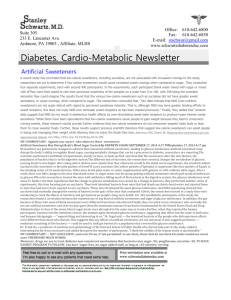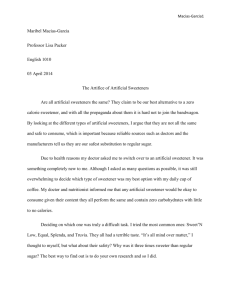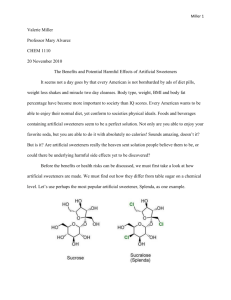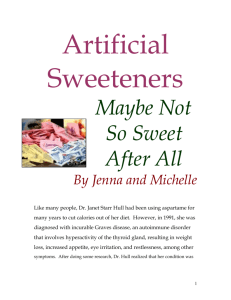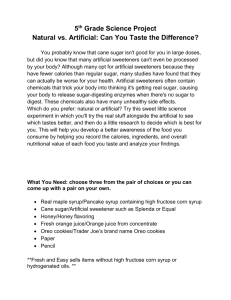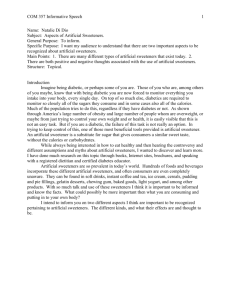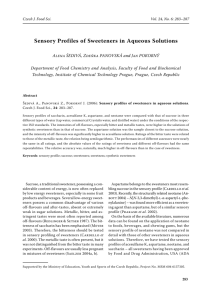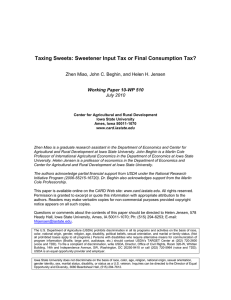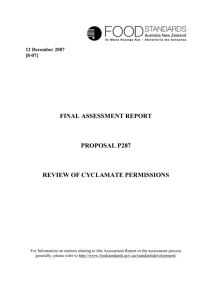Self-Assessment
advertisement
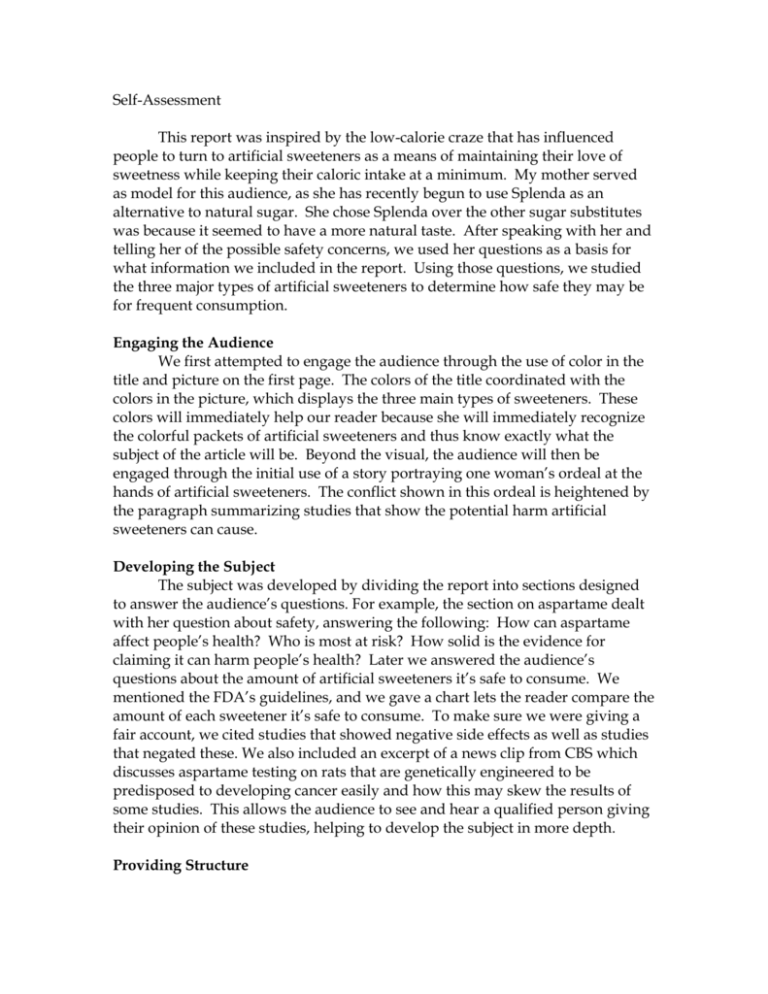
Self-Assessment This report was inspired by the low-calorie craze that has influenced people to turn to artificial sweeteners as a means of maintaining their love of sweetness while keeping their caloric intake at a minimum. My mother served as model for this audience, as she has recently begun to use Splenda as an alternative to natural sugar. She chose Splenda over the other sugar substitutes was because it seemed to have a more natural taste. After speaking with her and telling her of the possible safety concerns, we used her questions as a basis for what information we included in the report. Using those questions, we studied the three major types of artificial sweeteners to determine how safe they may be for frequent consumption. Engaging the Audience We first attempted to engage the audience through the use of color in the title and picture on the first page. The colors of the title coordinated with the colors in the picture, which displays the three main types of sweeteners. These colors will immediately help our reader because she will immediately recognize the colorful packets of artificial sweeteners and thus know exactly what the subject of the article will be. Beyond the visual, the audience will then be engaged through the initial use of a story portraying one woman’s ordeal at the hands of artificial sweeteners. The conflict shown in this ordeal is heightened by the paragraph summarizing studies that show the potential harm artificial sweeteners can cause. Developing the Subject The subject was developed by dividing the report into sections designed to answer the audience’s questions. For example, the section on aspartame dealt with her question about safety, answering the following: How can aspartame affect people’s health? Who is most at risk? How solid is the evidence for claiming it can harm people’s health? Later we answered the audience’s questions about the amount of artificial sweeteners it’s safe to consume. We mentioned the FDA’s guidelines, and we gave a chart lets the reader compare the amount of each sweetener it’s safe to consume. To make sure we were giving a fair account, we cited studies that showed negative side effects as well as studies that negated these. We also included an excerpt of a news clip from CBS which discusses aspartame testing on rats that are genetically engineered to be predisposed to developing cancer easily and how this may skew the results of some studies. This allows the audience to see and hear a qualified person giving their opinion of these studies, helping to develop the subject in more depth. Providing Structure The first page is almost entirely composed of the title and a picture of the sweeteners. These are designed to create expectations in the reader of what is to come later in the report. The introduction summarizes what will be covered in the later sections of the paper, establishing a given for later information. We then used headings to separate the different sections so that they are distinct. The first three sections discuss the different sweeteners, moving from the information the reader knows (the brand name of the sweetener) to the new information that they have not been exposed to, such as studies on the chemical. The rest of the paper is divided into subjects of additional topics about sweeteners that are also of interest to the audience. Visuals were used sparingly to break up the text and provide additional support of the topics being discussed. Self-Assessment This report was inspired by the low-calorie craze that has influenced people to turn to artificial sweeteners as a means of maintaining their love of sweetness while keeping their caloric intake at a minimum. Jenna’s mother served as model for this audience, as she has recently begun to use Splenda as an alternative to natural sugar. She chose Splenda over the other sugar substitutes was because it seemed to have a more natural taste. After speaking with her and telling her of the possible safety concerns, we used her questions as a basis for what information we included in the report. Using those questions, we studied the three major types of artificial sweeteners to determine how safe they may be for frequent consumption. Engaging the Audience We first attempted to engage the audience through the use of color in the title and picture on the first page. The colors of the title coordinated with the colors in the picture, which displays the three main types of sweeteners. These colors will immediately help our reader because she will immediately recognize the colorful packets of artificial sweeteners and thus know exactly what the subject of the article will be. Beyond the visual, the audience will then be engaged through the initial use of a story portraying one woman’s ordeal at the hands of artificial sweeteners. The conflict shown in this ordeal is heightened by the paragraph summarizing studies that show the potential harm artificial sweeteners can cause. Developing the Subject The subject was developed by dividing the report into sections designed to answer the audience’s questions. For example, the section on aspartame dealt with her question about safety, answering the following: How can it affect people’s health? Who is most at risk? How solid is the evidence for claiming it can harm people’s health? Late we answered the audience’s questions about the amount of artificial sweeteners it’s safe to consume. We mentioned the FDAs guidelines, and we gave a chart lets the reader compare the amount of each sweetener it’s safe to consume. The introduction was designed as a hook to capture the audience’s attention on the subject of the safety of artificial sweeteners while also introducing them to the overall topic of the report. The first three main sections specifically addressed the three main types of artificial sweeteners—aspartame, saccharin, and sucralose—and the further sections discussed other important issues to the audience, including safety information, alternatives, and taste comparisons. When discussing the types of sweeteners independently, we We cited studies that showed negative side effects as well as studies that negated these. We also summarized the FDA’s position on the chemicals. The later topics were ones that our target audience (using Jenna’s mother as a model) had specific questions about and thus were answered in as much depth as she indicated she would be interested in. We also included an excerpt of a news clip from CBS which discusses aspartame testing on rats that are genetically engineered to be predisposed to developing cancer easily and how this may skew the results of some studies. This allows the audience to see and hear a qualified person giving their opinion of these studies, helping to develop the subject in more depth. Providing Structure The first page is almost entirely composed of the title and a picture of the sweeteners. These are designed to create expectations in the reader of what is to come later in the report. These expectations are necessary so that the audience will want to continue. The few sentences on the first page are part of the introduction which is supposed to hook the audience with its story. After the story, the introduction summarizes what will be covered in the later sections of the paper, establishing a given for later information. We then used headings to separate the different sections so that they are distinct. and each can serve as a given for the next section. The first three sections discuss the different sweeteners, moving from the information the reader knows (the brand name of the sweetener) to the new information that they have not been exposed to, such as studies on the chemical. The rest of the paper is divided into subjects of additional topics about sweeteners that are also of interest to the audience. Visuals were used sparingly to break up the text and provide additional support of the topics being discussed.
